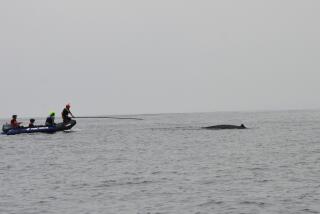Lahaina Keeps an Eye Out for Humphrey--and Dollars
LAHAINA, Hawaii — Humphrey the wayward whale may not have arrived here from California, but its famous name certainly has.
In this sunny waterfront town, where whale-watching tours and whale souvenirs are big business, the celebrity humpback provides a popular lure for tourist dollars.
“See the whales,” one whale watching cruise advertises. “Take close-up photographs of their antics as they play on their ‘winter vacation’ and maybe snap a picture of Humphrey.”
The 40-foot humpback has been expected to show up in Hawaii--the species’ largest breeding area in the North Pacific--ever since rescuers freed it from the Sacramento River and herded it out the Golden Gate last November.
No Sign of Humphrey
But so far, Humphrey has disappointed fans and researchers alike, who are hoping for some sign that the independent-minded mammal survived its freshwater ordeal. The whale’s whereabouts remain a mystery--especially since it foiled the attempts of federal biologists to implant a transmitter in its blubber.
Humphrey’s arrival in Hawaii can be determined conclusively only by photographing its flukes or flippers and matching the photo with pictures taken of the whale during its 26-day inland odyssey.
Naturally, that hasn’t stopped the promoters.
Radio station KMUI is offering a free weekend at a Maui resort hotel for anyone who takes a verified photo of Humphrey in Hawaiian waters. In Lahaina, sales clerks at several shops report a brisk business in Humphrey T-shirts, Humphrey stuffed whales and bronze sculptures titled simply, “Humphrey.”
A popular item at the Ecology House is a shirt that shows Humphrey’s route up the Sacramento River. “Almost everyone from California who comes in buys one,” said sales clerk Denise Mullen.
Lahaina, a town of T-shirt shops, boutiques and bars, once thrived on trade with whaling ships. From 1840 to 1860, ships filled the harbor and the town was a haven for whaling crews on voyages that lasted as long as three years.
Historians say that sightings of humpbacks in the Hawaiian Islands were not reported until about 1840 and that the animal played little part in native Hawaiian culture.
Grog Shops and Bars
Early whalers rarely attempted to hunt the humpbacks off Maui. In those days, the animal was a less desirable prey than other rorquals--and certainly less entertaining after a long journey than the pleasures offered by Lahaina.
At the pre-Civil War peak of whaling, there were 28 grog shops in the Lahaina area--the same number of bars there are today, said James Luckey, head of the Lahaina Restoration Society. Whaling ships once fired their cannons at the home of a missionary who tried to prevent the sailors from associating with the women of the town.
During the last decade, the town has become Hawaii’s largest port for whale-watching cruises--a business now worth at least $3 million a year. The peak season is from January to May.
“The area that was once the center for those setting out to kill the whales is now the center for saving them,” Luckey said. “That’s sort of a poetic justice.”
More to Read
Sign up for The Wild
We’ll help you find the best places to hike, bike and run, as well as the perfect silent spots for meditation and yoga.
You may occasionally receive promotional content from the Los Angeles Times.






